The 2009 Season
Gate Passageway
In 1996 the west chamber of the gate of the fortress of Joshua’s time (LB I, 15th century BC), was excavated. Much evidence for fire in the form of burned stones and calcined bedrock was found. The east chamber of the gate is no longer in existence as all of its stones were removed for later construction, most likely when another fortress was built over the east half the LB I fortress in the second century BC. In 2009, the gate passageway in Square R17 was excavated to bedrock. The passageway sub layers were found to be comprised of clay fill on bedrock. The bedrock throughout the passageway is fractured and disintegrated, and the clay and bedrock are red in color. All of this appears to be the result of an intense fire in the LB I gate passageway in antiquity, most likely from the burning of Ai recorded in Joshua 8:28.
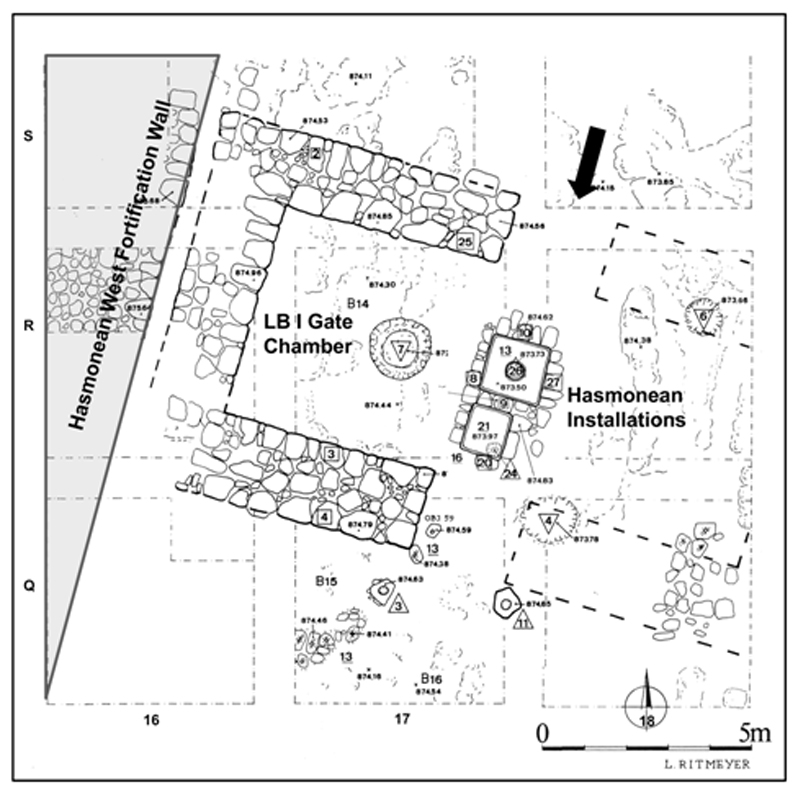
Plan of the gate area on the north side of the Late Bronze (LB) I fortress. Obj. 59 is an upper gate socket stone, 3 and 11 are lower gate socket stones. The Hasmonean installations and west fortification wall are later constructions from a fortress built over the east half of the LB I fortress during the Hasmonean period (152–37 BC). Leen Ritmeyer. (Click on image to enlarge).
A number of poorly-reserved walls have been found inside the gate of the LB I fortress. In 2009 an infant jar burial was discovered between two of these walls, in the northeast corner of Square O18. The burial jar was 15 in (37 cm) below the ground, resting on bedrock. Four offering vessels were placed around the outside of the jar, which faced south. In the MB period, grave goods were typically placed inside the burial jar, along with the remains of the interred, whereas in the LB I period placement outside the jar became more common. A hole had been cut into the bottom of the jar to insert the remains of the infant. This type of insertion is somewhat unusual since in the vast majority of infant jar burials the neck and rim were broken off, and insertion was made from the top of the jar. The mostly broken bones of an infant around the age of birth were found scattered around the outside of the jar. The remains had been removed from the jar in antiquity, undoubtedly by a rodent.
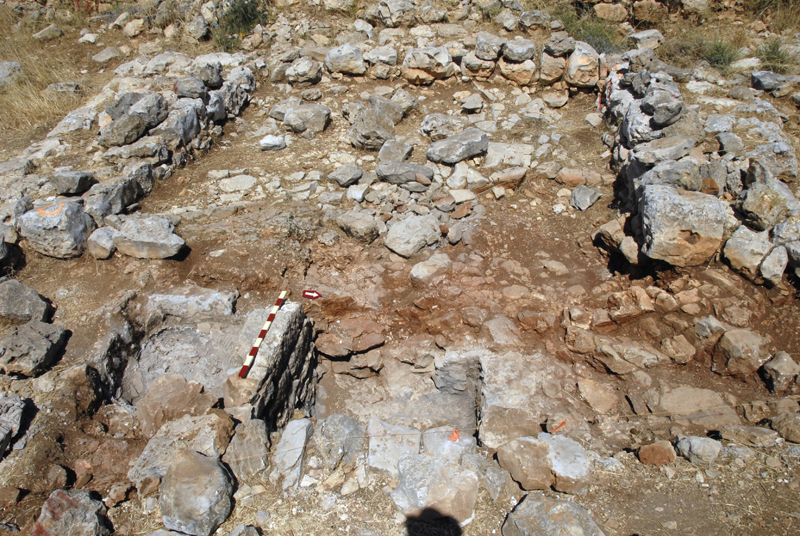
Passageway of the LB I gate, view west. In the upper half of the photo is the west chamber of the gate, with walls 6.5 ft (2 m) wide. In the foreground is the burned passageway. The two small rectangular installations in the lower part of the photo are from the second–first centuries BC. Mike Luddeni
Intramural (within the walls) infant jar burials were common in urban settings in the Middle Bronze (MB) period (ca. 1900–1500 BC) and less common in the LB I period (ca. 1500–1400 BC). At one time it was thought that such burials were infant sacrifices. Since large numbers of these burials have been found, and infant mortality was high in antiquity, it is now believed that they were simply ordinary burials made beneath the floors of houses so that the family could have their deceased infant close by.
Two of the offering vessels, a dipper juglet and piriform juglet, are the most common grave goods found with infant jar burials. The other two, a small flat-bottomed cooking pot and a pedestal vase, however, are unique to infant jar burials. The four vessels date to the end of the MB period, whereas the burial jar itself is LB I in date. The typology of the burial, the offering vessels and the burial jar indicate a date for the internment early in the life of the LB I fortress, somewhere around 1500 BC.

Plan of the LB I gate and walls inside the gate. In 2009 an infant jar burial was found between two of the walls, in the northeast corner of Square O18. Leen Ritmeyer
The cooking pot and the pedestal vase are significant because they are non-traditional. Kh. el-Maqatir was an out-of-the way border outpost, so it is possible that traditional offering vessels were not available. Since the cooking pot was a simple utilitarian vessel that was readily available, it might have been pressed into service as a container for a food offering. The pedestal vase, on the other hand, was an expensive finely made item of table ware indicating an elite status for the residents of the building. In the Bronze and Iron Ages important administrative buildings were many times located near the city gate. Our building was perhaps a residency serving as the administrative headquarters for the fortress, as well as the commandant’s living quarters. The presence of an infant burial indicates that women were present in the fortress, a fact alluded to in Scripture (Joshua 8:25).
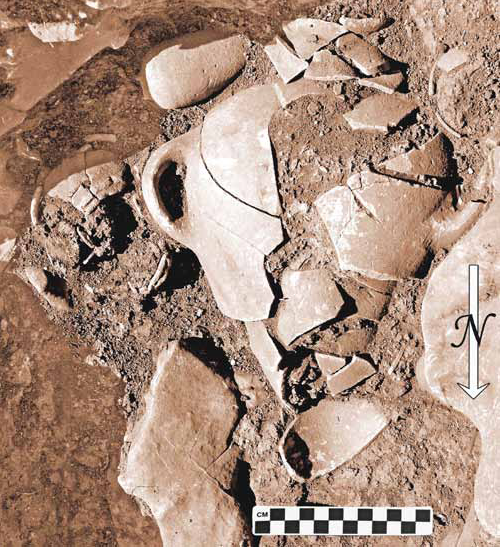
Infant burial jar and offering vessels. Remains of an infant around the age of birth were placed in the jar and buried beneath the floor of a building just inside the gate of the LB I fortress. The location of the building and a fine ware pedestal vase included with the burial suggest the structure was the commandants’ headquarters. The find confirms that there were women in the fortress as stated in Joshua 8:25. Mike Luddeni
The 2010 Season
A Major Wall
Although the north, west and southern walls of the LB I fortress have been located, we have yet to find the east wall. After several seasons of searching, we may now have found it. In the southeast corner of Square G17 the inside face of a wall was exposed during the 2010 season. The presence of a megalithic stone 6.5 ft long (2 m) and 3.3 ft (1 m) high indicate that this was a significant wall. Pottery found in association with the wall dates to the LB I period. We hope to determine the width of the wall and confirm its dating during the 2011 season.

Inner face of a significant wall in Square G17. The very large stone suggests that this was an important wall, possibly the east fortification wall of the LB I fortress. Mike Luddeni
West Wall of the LB I Fortress
In the 2000 season a probe trench on the west side of the LB I fortress revealed the west fortification wall. During the 2009 and 2010 seasons a section was cut through the wall to obtain pottery for dating purposes, and also to clarify its construction. Even though it appears that the inner and outer faces of the LB I wall were partially robbed out, the wall is still preserved to a width of 12 ft (3.7 m) at its base. This compares to a width of 13 ft (4 m) for the northern section of the fortress wall. On the inside of the LB I wall, a massive addition 16 ft (5 m) in width was constructed in the Hasmonean period.
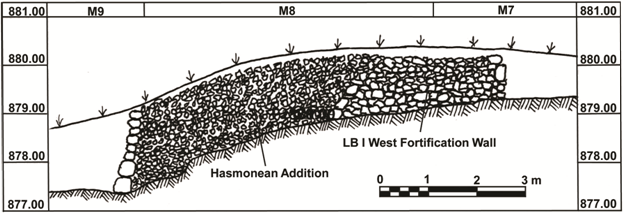
South section through the west LB I fortification wall and later Hasmonean addition. Oral Collins
The most significant aspect of the Hasmonean addition is that the pottery in the structure is primarily LB I in date, and nearly all of this pottery had been refired to a cement-like hardness. This leads to the conclusion that when the Hasmoneans built the addition, they used debris from the destroyed LB I fortress, including pottery which had been burned by a severe conflagration. Although we do not have a thick layer of ash to prove the burning of Ai, since that eroded away centuries ago, we do have considerable amounts of refired LB I pottery, not only from the west Hasmonean addition but from other areas as well, that attest the fortress was destroyed by fire at the end of the 15th century BC.
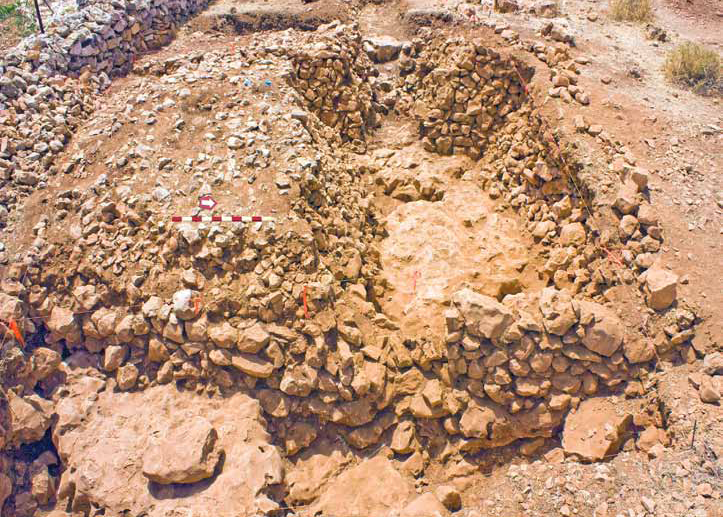
Section through west wall, view west. In the foreground is the inner face of a Hasmonean addition to the interior of the LB I wall. The inner face of the LB I wall can be seen in the upper portion of the photo. Mike Luddeni
Notes
[1] For reports of previous seasons, see Bolen 1999; Wood 1999a, 1999b, 2000a, 2000b, 2000c, 2001, 2008, 2009b. For reports of the 2009 season, see Wood 2009a, 2010.
Bibliography
Bolen, Todd
1999 The Byzantine Church of Khirbet el-Maqatir, Bible and Spade 12: 91–94.
Wood, Bryant G.
1999a Kh. el-Maqatir 1999 Dig Report. Bible and Spade 12: 109–14.
1999b The Search for Joshua's Ai: Excavations at Kh. el-Maqatir. Bible and Spade 12: 21–30.
2000a Kh. el-Maqatir 2000 Dig Report. Bible and Spade 13: 67–72.
2000b Khirbet el-Maqatir, 1995–1998. Israel Exploration Journal 50: 123–30.
2000c Khirbet el-Maqatir, 1999. Israel Exploration Journal 50: 249–54.
2001 Khirbet el-Maqatir, 2000. Israel Exploration Journal 51: 246–52.
2008 The Search for Joshua’s Ai. Pp. 205–40 in Critical Issues in Early Israelite History, eds. Richard S. Hess, Gerald A. Klingbeil and Paul J. Ray, Jr. Winona Lake IN: Eisenbrauns.
2009a The ABR Excavation at Khirbet el-Maqatir: Review of Past Work and Report on the 2009 Season. ABR Newsletter 9.7.
2009b Researching Ai. Bible and Spade 22: 75–78.
2010 ABR’s 2009 Excavation at Khirbet el-Maqatir: The Infant Jar Burial. ABR Newsletter 10.2.
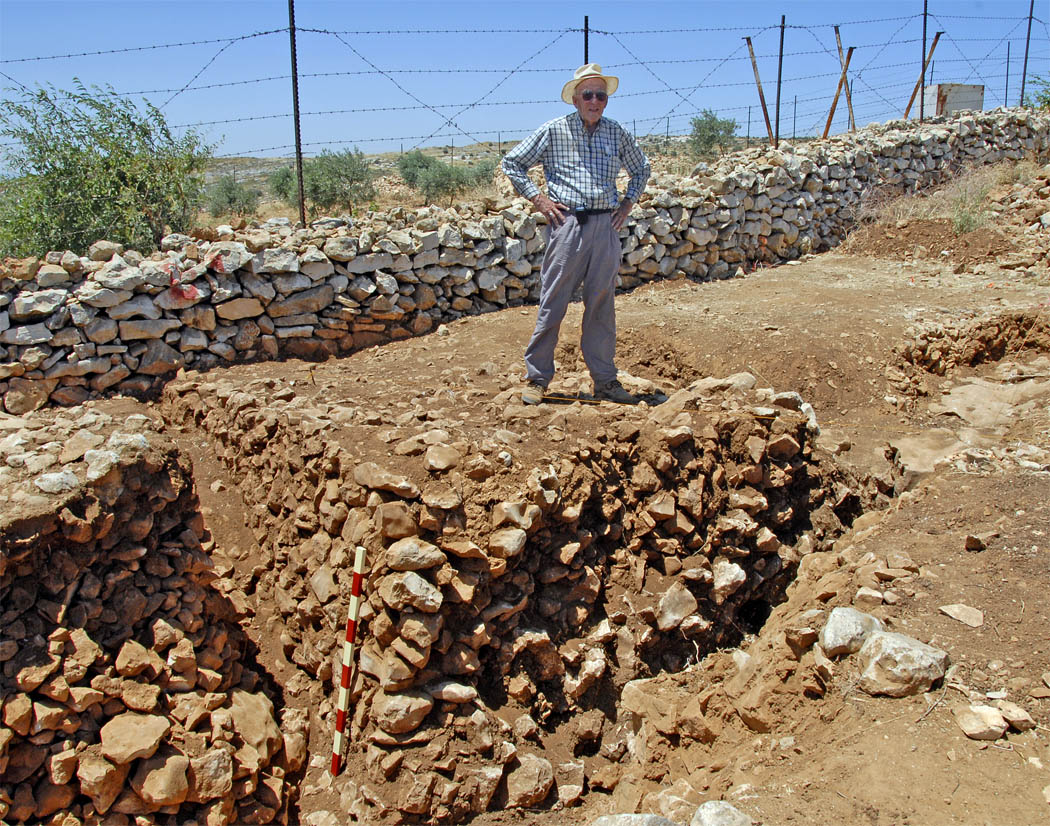
West wall of the 15th century BC fortress at Khirbet el-Maqatir: Square supervisor Oral Collins, of the Berkshire Institute for Christian Studies, stands atop the western fortification wall of the Late Bronze I (ca. 1500–1400 BC) fortress at Khirbet el-Maqatir, the proposed location of the Ai of Joshua 7-8, at the end of the 2009 excavation season. The preserved width of the wall is 12 ft (3.6 m) at its base and the remaining height is 4 ft (1.2 m). Behind Dr. Collins is a modern wall enclosing an agricultural area which covers the southwest sector of the fortress. Mike Luddeni